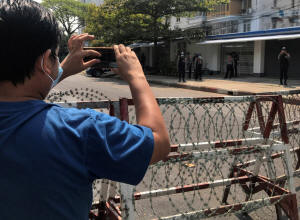|
He
has not been back.
His work now is on the city streets and his tool is his mobile
phone linked to Facebook Live - streaming the nationwide
protests against the coup that toppled elected leader Aung San
Suu Kyi and ended a decade of tentative democratic reforms.
"Despite the difficulties, citizen journalists and media are
posting in every possible way," Thar Lon Zaung Htet, 37, told
Reuters. "The important thing is we show the world what's
happening."
With established media under ever greater pressure, the story of
Myanmar's anti-coup protests is being shaped for its people and
the world by journalists and citizens streaming and sharing
snippets of video and pictures.
About half of Myanmar's 53 million people use the platform in a
country where Facebook became synonymous with the Internet
during a decade of reforms since 2011 that transformed what had
been one of the world's most isolated states.
Although Facebook was banned by the junta after it emerged as a
plaform for opposition, downloads of VPNs to skirt the block
have surged.
"This is very important for the Burmese people," said Zayar
Hlaing, a veteran journalist and former member of the Myanmar
Press Council. "People need to know what happened where, to whom
so they can decide what to do."
Myanmar's military-appointed information ministry did not
respond to a request for comment on livestreaming and the role
of citizen journalists.
DOZENS OF STREAMS
Three local outlets alone did 65 Facebook livestreams on Feb.
22, the day of the biggest protests so far. One video from Thar
Lon Zaung Htet's Khit Thit Media got more than 185,000 views -
one of the most watched clips.
Facebook declined to comment on the role of live video in
Myanmar but said the platform has been used around the world by
people seeking to raise awareness of social issues and highlight
injustice.
On Thursday, Facebook banned the military with immediate effect,
citing "exceptionally severe human rights abuses and the clear
risk of future military-initiated violence" as well as the
army's repeated history of violating its rules. The military has
not commented on this.
Thar Lon Zaung Htet became a journalist under the previous junta
in 2003, but said that now he was more afraid than ever. Remote
working is the rule for all nine staff at his news agency, which
is financed by local civil society groups.
"This is the worst situation we have known," he said.
Press freedom groups had complained that the environment was
getting tougher even under Suu Kyi, with RSF (Reporters without
Borders) rankings showing Myanmar falling every year since 2018
- although it was still markedly more open than it had been in
the years of censorship and control under full military rule.
At least nine journalists have been detained since the Feb. 1
coup, according to data from Myanmar's Assistance Association
for Political Prisoners. All but two have now been released.
Journalists also say they have been chased down, blocked and
intimidated by security forces and shot with rubber bullets. A
group from 74 Media in northern Kachin State livestreamed their
own arrest.
The ruling generals have said they value accurate reporting, but
also threatened to withdraw the licences of media that do not
stick to demands to stop referring to the ruling council as a
"junta" and the army takeover as a "coup".
The military-appointed government did not respond to questions
on media freedom.
A group of independent local media said on Thursday that
government statements since the coup contradicted constitutional
provisions on free reporting and broadcasting and that they
would continue to work in accordance with media ethics.
"DIGITAL RESISTANCE"
Alongside local media, a growing number of activists, protesters
and members of the public are shooting pictures to share with
the world.
"They are the front of the digital resistance," said Emilie
Pradichit, founder of the Bangkok-based Manushya Foundation
rights group. "They are the ones disseminating information for
all of us. They are also facing the same risk."
Such videos have become an important source of images for
foreign media, including Reuters.
When security forces opened fire on protesters on Feb. 20 in
Myanmar's second city of Mandalay, killing two people,
bystanders recorded the scenes from multiple angles. Someone
even had a drone.
State media reported that striking shipyard workers attacked
police and some "aggressive protesters" were hurt due to
security measures.
One man described the horror of watching one of the two victim's
bleed to death in the dust as he recorded video to share with
the world. The amateur videographer did not want to be named for
fear of reprisals.
As well as the risk of violence or arrest, just getting the
video out is complicated by internet blackouts, which are now in
force daily from 1 a.m. to 9 a.m. and have been imposed at other
times when tension was high.
Some livestreamers have nonetheless found ways to skirt the
blocks on data transmission on local mobile networks - even if
the video is sometimes shaky and blurred.
"We will figure the things out in every possible way that we
can," said Thar Lon Zaung Htet. "No matter what."
(Writing by Matthew Tostevin; Editing by Angus MacSwan)
[© 2021 Thomson Reuters. All rights
reserved.] Copyright 2021 Reuters. All rights reserved. This material may not be published,
broadcast, rewritten or redistributed.
Thompson Reuters is solely responsible for this content.

|
|




